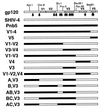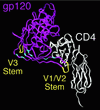HIV type I envelope determinants for use of the CCR2b, CCR3, STRL33, and APJ coreceptors
- PMID: 9736741
- PMCID: PMC21647
- DOI: 10.1073/pnas.95.19.11360
HIV type I envelope determinants for use of the CCR2b, CCR3, STRL33, and APJ coreceptors
Abstract
The envelope (Env) proteins of primate lentiviruses interact sequentially with CD4 and a coreceptor to infect cells. Changes in coreceptor use strongly influence viral tropism and pathogenesis. We followed the evolution of coreceptor use in pig-tailed macaques that developed severe CD4 T-cell loss during the derivation of a pathogenic simian HIV (SHIV) that contained the tat, rev, vpu, and env genes of the HXBc2 strain of HIV-1 in a genetic background of SIVmac239. The Env from the parental virus as well as one derived from the first macaque to develop AIDS exclusively used CXCR4 as a coreceptor, indicating that CXCR4 can function as a coreceptor in macaques even though it is rarely used by simian immunodeficiency viruses. One Env (Pnb5), obtained from a macrophage-tropic virus isolated from the cerebral spinal fluid, did not use CCR5 or CXCR4. Instead, it used CCR2b and to a lesser extent CCR3, STRL33, and APJ to infect cells. Chimeras between Pnb5 and the parental X4 Env indicated that the V3 loop is the major determinant of CXCR4 use, with other regions of Env influencing the efficiency with which this coreceptor was used. In contrast, the Pnb5 V1/2 and V3 regions in combination were both necessary and sufficient to confer full use of CCR2b, CCR3, STRL33, and APJ to the parental X4 Env protein. These results are consistent with a single, conserved binding site in Env that interacts with multiple coreceptors in conjunction with the V1/2 and V3 loops, and suggest that the V1/2 region plays a more important role in governing the use of CCR2b, CCR3, STRL33, and APJ than for CXCR4.
Figures





Similar articles
-
Patterns of chemokine receptor fusion cofactor utilization by human immunodeficiency virus type 1 variants from the lungs and blood.J Virol. 1999 Aug;73(8):6680-90. doi: 10.1128/JVI.73.8.6680-6690.1999. J Virol. 1999. PMID: 10400765 Free PMC article.
-
Utilization of chemokine receptors, orphan receptors, and herpesvirus-encoded receptors by diverse human and simian immunodeficiency viruses.J Virol. 1997 Dec;71(12):8999-9007. doi: 10.1128/JVI.71.12.8999-9007.1997. J Virol. 1997. PMID: 9371556 Free PMC article.
-
Use of GPR1, GPR15, and STRL33 as coreceptors by diverse human immunodeficiency virus type 1 and simian immunodeficiency virus envelope proteins.Virology. 1998 Sep 30;249(2):367-78. doi: 10.1006/viro.1998.9306. Virology. 1998. PMID: 9791028
-
Chemokine receptors and virus entry in the central nervous system.J Neurovirol. 1999 Dec;5(6):643-58. doi: 10.3109/13550289909021293. J Neurovirol. 1999. PMID: 10602405 Review.
-
Chemokine receptors as fusion cofactors for human immunodeficiency virus type 1 (HIV-1).Immunol Res. 1997 Feb;16(1):15-28. doi: 10.1007/BF02786321. Immunol Res. 1997. PMID: 9048206 Review.
Cited by
-
Involvement of both the V2 and V3 regions of the CCR5-tropic human immunodeficiency virus type 1 envelope in reduced sensitivity to macrophage inflammatory protein 1alpha.J Virol. 2000 Feb;74(4):1787-93. doi: 10.1128/jvi.74.4.1787-1793.2000. J Virol. 2000. PMID: 10644351 Free PMC article.
-
Residues in the membrane-spanning domain core modulate conformation and fusogenicity of the HIV-1 envelope glycoprotein.Virology. 2010 Sep 1;404(2):158-67. doi: 10.1016/j.virol.2010.03.016. Epub 2010 Jun 1. Virology. 2010. PMID: 20605619 Free PMC article.
-
Neuropathogenesis of lentiviral infection in macaques: roles of CXCR4 and CCR5 viruses and interleukin-4 in enhancing monocyte chemoattractant protein-1 production in macrophages.Am J Pathol. 2002 Sep;161(3):813-22. doi: 10.1016/S0002-9440(10)64241-1. Am J Pathol. 2002. PMID: 12213709 Free PMC article.
-
Early events of HIV-1 infection: can signaling be the next therapeutic target?J Neuroimmune Pharmacol. 2011 Jun;6(2):269-83. doi: 10.1007/s11481-011-9268-5. Epub 2011 Mar 5. J Neuroimmune Pharmacol. 2011. PMID: 21373988 Review.
-
Virus entry via the alternative coreceptors CCR3 and FPRL1 differs by human immunodeficiency virus type 1 subtype.J Virol. 2009 Sep;83(17):8353-63. doi: 10.1128/JVI.00780-09. Epub 2009 Jun 24. J Virol. 2009. PMID: 19553323 Free PMC article.
References
-
- Doms R W, Peiper S C. Virology. 1997;235:179–190. - PubMed
-
- Broder C C, Collman R G. J Leukocyte Biol. 1997;62:20–29. - PubMed
-
- Moore J P, Trkola A, Dragic T. Curr Opin Immunol. 1997;9:551–562. - PubMed
-
- Bieniasz P D, Cullen B R. Front Biosci. 1998;3:44–58. - PubMed
-
- Berger E A. AIDS. 1997;11:S3–S16. - PubMed
Publication types
MeSH terms
Substances
Grants and funding
LinkOut - more resources
Full Text Sources
Other Literature Sources
Research Materials

